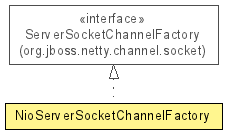 org.jboss.netty.channel.socket.nio.NioServerSocketChannelFactory
org.jboss.netty.channel.socket.nio.NioServerSocketChannelFactory
|
||||||||||
| PREV CLASS NEXT CLASS | FRAMES NO FRAMES | |||||||||
| SUMMARY: NESTED | FIELD | CONSTR | METHOD | DETAIL: FIELD | CONSTR | METHOD | |||||||||
java.lang.Objectorg.jboss.netty.channel.socket.nio.NioServerSocketChannelFactory
public class NioServerSocketChannelFactory

A ServerSocketChannelFactory which creates a server-side NIO-based
ServerSocketChannel. It utilizes the non-blocking I/O mode which
was introduced with NIO to serve many number of concurrent connections
efficiently.
There are two types of threads in a NioServerSocketChannelFactory;
one is boss thread and the other is worker thread.
Each bound ServerSocketChannel has its own boss thread.
For example, if you opened two server ports such as 80 and 443, you will
have two boss threads. A boss thread accepts incoming connections until
the port is unbound. Once a connection is accepted successfully, the boss
thread passes the accepted Channel to one of the worker
threads that the NioServerSocketChannelFactory manages.
One NioServerSocketChannelFactory can have one or more worker
threads. A worker thread performs non-blocking read and write for one or
more Channels in a non-blocking mode.
All threads are acquired from the Executors which were specified
when a NioServerSocketChannelFactory was created. Boss threads are
acquired from the bossExecutor, and worker threads are acquired from
the workerExecutor. Therefore, you should make sure the specified
Executors are able to lend the sufficient number of threads.
It is the best bet to specify a cached thread pool.
Both boss and worker threads are acquired lazily, and then released when
there's nothing left to process. All the related resources such as
Selector are also released when the boss and worker threads are
released. Therefore, to shut down a service gracefully, you should do the
following:
ChannelGroup.close())releaseExternalResources().RejectedExecutionException
and the related resources might not be released properly.
| Constructor Summary | |
|---|---|
NioServerSocketChannelFactory(Executor bossExecutor,
Executor workerExecutor)
Creates a new instance. |
|
NioServerSocketChannelFactory(Executor bossExecutor,
Executor workerExecutor,
int workerCount)
Creates a new instance. |
|
| Method Summary | |
|---|---|
ServerSocketChannel |
newChannel(ChannelPipeline pipeline)
Creates and opens a new Channel and attaches the specified
ChannelPipeline to the new Channel. |
void |
releaseExternalResources()
Releases the external resources that this factory depends on to function. |
| Methods inherited from class java.lang.Object |
|---|
clone, equals, finalize, getClass, hashCode, notify, notifyAll, toString, wait, wait, wait |
| Constructor Detail |
|---|
public NioServerSocketChannelFactory(Executor bossExecutor,
Executor workerExecutor)
NioServerSocketChannelFactory(Executor, Executor, int) with 2 *
the number of available processors in the machine. The number of
available processors is obtained by Runtime.availableProcessors().
bossExecutor - the Executor which will execute the boss threadsworkerExecutor - the Executor which will execute the I/O worker threads
public NioServerSocketChannelFactory(Executor bossExecutor,
Executor workerExecutor,
int workerCount)
bossExecutor - the Executor which will execute the boss threadsworkerExecutor - the Executor which will execute the I/O worker threadsworkerCount - the maximum number of I/O worker threads| Method Detail |
|---|
public ServerSocketChannel newChannel(ChannelPipeline pipeline)
ChannelFactoryChannel and attaches the specified
ChannelPipeline to the new Channel.
newChannel in interface ChannelFactorynewChannel in interface ServerChannelFactorynewChannel in interface ServerSocketChannelFactorypipeline - the ChannelPipeline which is going to be
attached to the new Channel
public void releaseExternalResources()
ChannelFactoryExecutors that you specified in the factory
constructor are external resources. You can call this method to release
all external resources conveniently when the resources are not used by
this factory or any other part of your application. An unexpected
behavior will be resulted in if the resources are released when there's
an open channel which is managed by this factory.
releaseExternalResources in interface ChannelFactoryreleaseExternalResources in interface ExternalResourceReleasable
|
||||||||||
| PREV CLASS NEXT CLASS | FRAMES NO FRAMES | |||||||||
| SUMMARY: NESTED | FIELD | CONSTR | METHOD | DETAIL: FIELD | CONSTR | METHOD | |||||||||